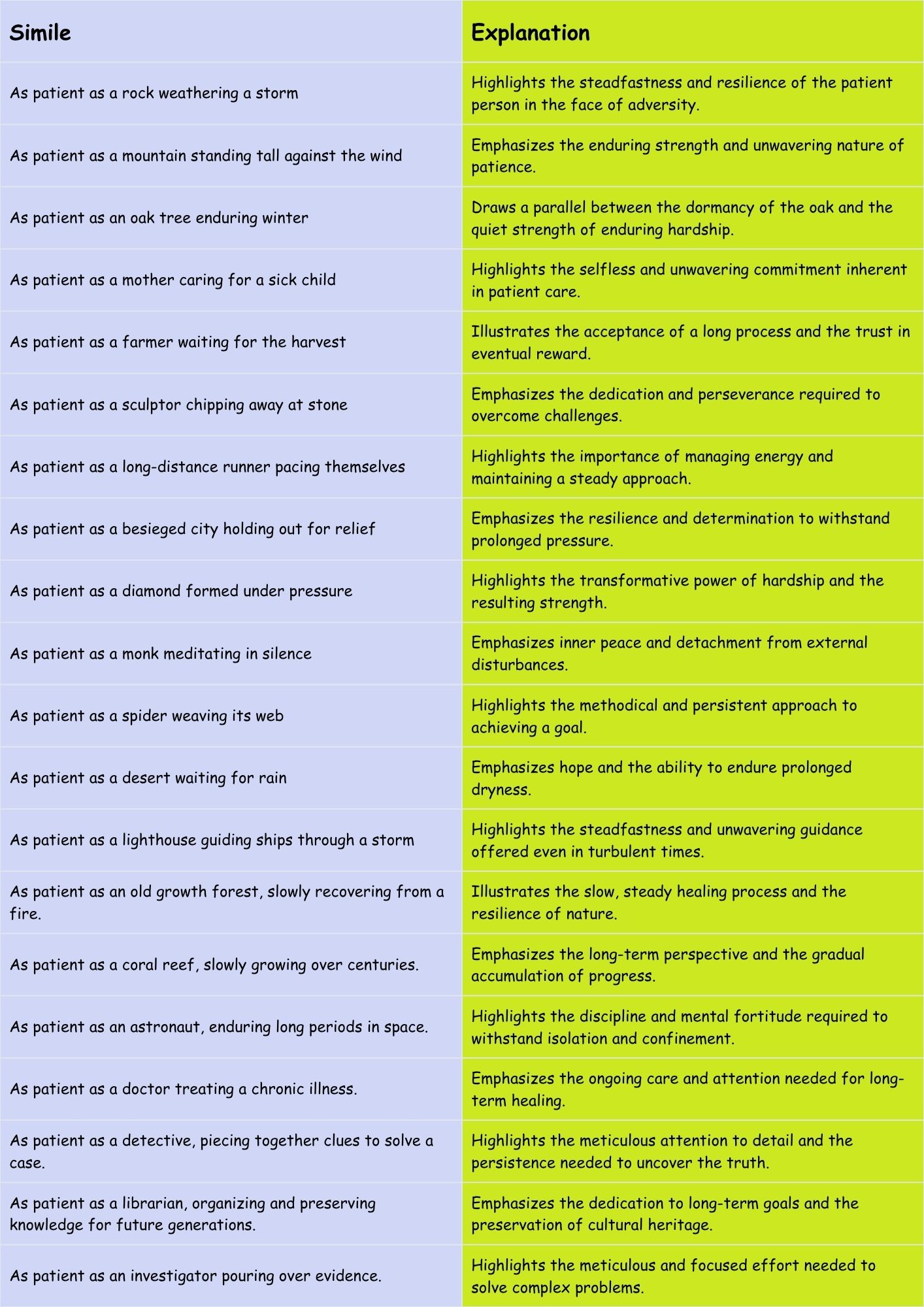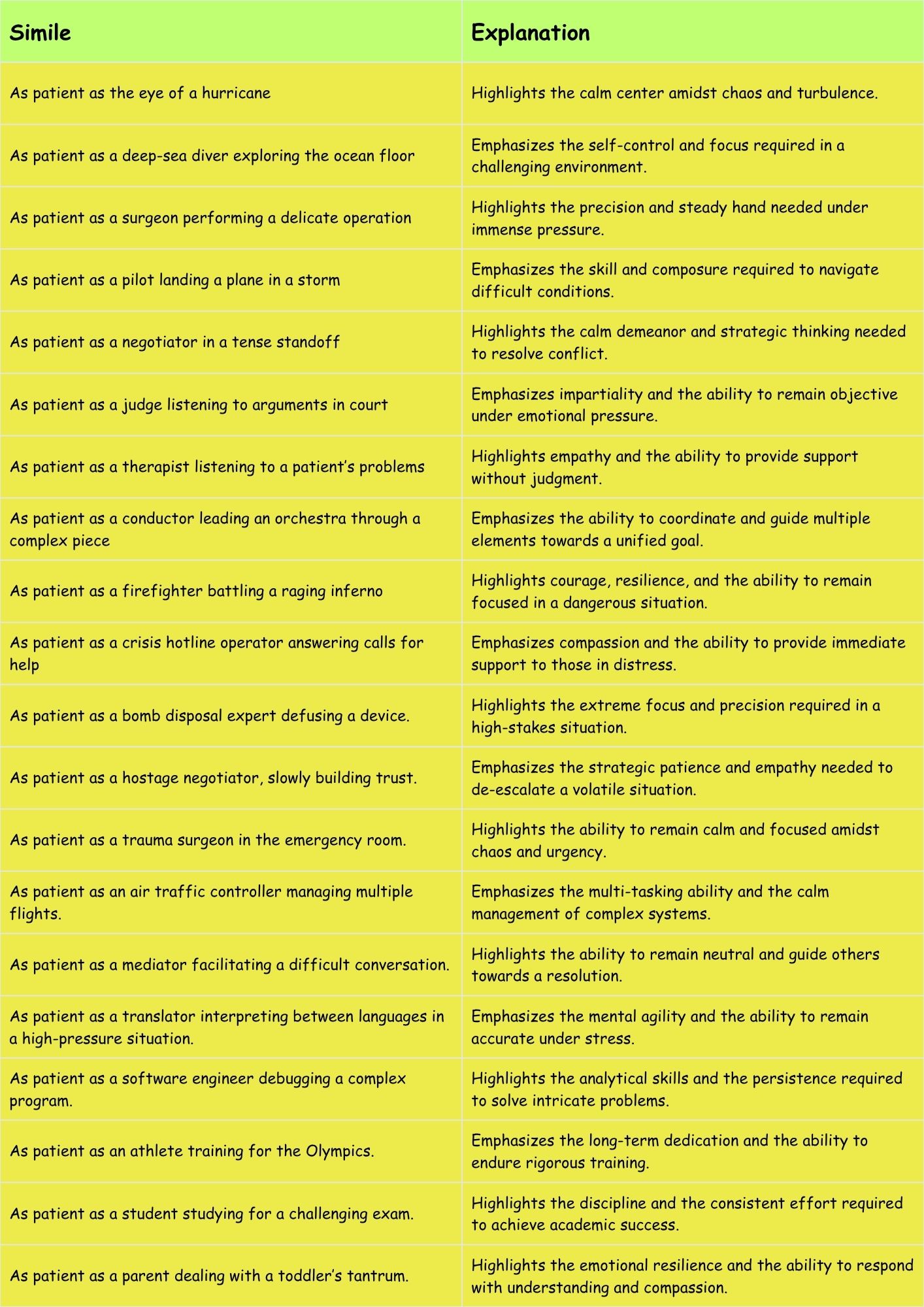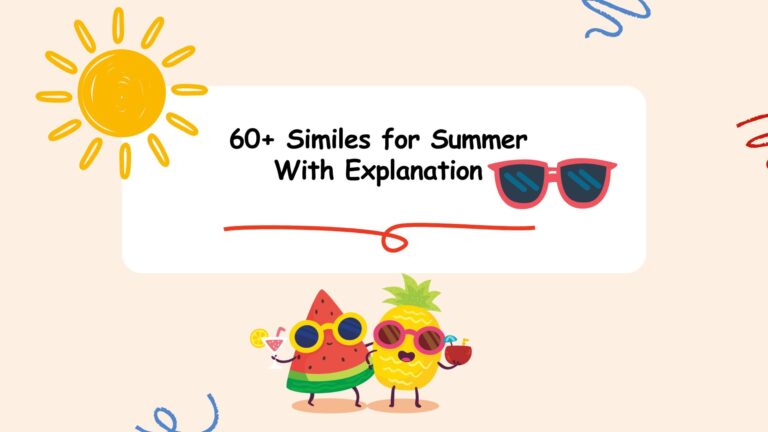
Similes for Patience: A Comprehensive Guide

Patience, the ability to endure waiting, delay, or provocation without becoming annoyed or upset, is a virtue often praised but difficult to practice. Similes, figures of speech that compare two unlike things using “like” or “as,” can vividly illustrate the concept of patience and its various facets. This article will explore a wide range of similes for patience, providing detailed explanations, examples, and exercises to enhance your understanding and usage. Whether you’re an English language learner, a writer seeking to enrich your descriptions, or simply someone interested in exploring the nuances of language, this guide will equip you with the knowledge to effectively employ similes to convey the essence of patience.
Table of Contents
- Introduction
- Definition of Similes for Patience
- Structural Breakdown of Similes
- Types of Patience Depicted by Similes
- Examples of Similes for Patience
- Usage Rules for Similes
- Common Mistakes with Similes
- Practice Exercises
- Advanced Topics: Metaphors and Beyond
- Frequently Asked Questions
- Conclusion
Definition of Similes for Patience
A simile is a figure of speech that compares two different things using the words “like” or “as.” Its purpose is to create a vivid image or understanding by drawing a parallel between the abstract concept of patience and something more concrete and relatable. Similes for patience highlight various aspects of this virtue, such as its strength, resilience, calmness, and endurance. They help us understand what patience *feels* like and *looks* like in different situations.
In the context of patience, similes can be used to describe:
- The act of waiting calmly.
- The ability to withstand hardship without complaint.
- The maintenance of composure under pressure.
- The gradual process of learning and developing patience.
The function of similes in describing patience is to add depth and color to our language. They go beyond simple definitions and allow us to connect with the concept on an emotional and imaginative level. By comparing patience to something tangible, we can better grasp its meaning and appreciate its value. For example, saying someone is “as patient as a saint” immediately conveys a sense of extraordinary forbearance and inner peace.
Structural Breakdown of Similes
A simile has a simple, yet effective structure. It consists of three key components:
- The Subject: The thing being described (in this case, patience or a patient person).
- The Connecting Word: “Like” or “as.” These words explicitly signal a comparison.
- The Object of Comparison: The thing that the subject is being compared to. This should be something familiar and easily understood.
The general formula for a simile is: Subject + Connecting Word + Object of Comparison.
For instance:
- “He was as patient as a seasoned teacher.” (He = Subject, as = Connecting Word, a seasoned teacher = Object of Comparison)
- “Her patience is like a deep well.” (Her patience = Subject, like = Connecting Word, a deep well = Object of Comparison)
The effectiveness of a simile relies on the strength and relevance of the comparison. The object of comparison should evoke qualities that are directly related to the aspect of patience being highlighted. A poorly chosen object can weaken the simile and make it less impactful.
Types of Patience Depicted by Similes
Patience is not a monolithic concept; it manifests in various forms depending on the situation. Similes can be crafted to reflect these different types:
Enduring Hardship
This type of patience involves bearing difficult circumstances with fortitude and without complaint. Similes here often involve comparisons to strong, resilient objects or creatures.
Waiting Patiently
This refers to the ability to wait calmly and without frustration for something to happen. Similes often evoke images of stillness, calm waters, or slow, steady growth.
Calmness Under Pressure
This type of patience involves maintaining composure and clear thinking in stressful or challenging situations. Similes often involve comparisons to things that remain stable and unaffected by external forces.
Teaching Patience
This aspect involves guiding others, especially when they are slow to learn or easily frustrated. Similes here might compare the patient teacher to a nurturing gardener or a wise mentor.
Developing Patience
This refers to the gradual process of cultivating patience as a character trait. Similes might illustrate this process with images of slow and steady growth, like a tree slowly maturing or a seed patiently germinating.
Examples of Similes for Patience
Here are various examples of similes for patience, categorized by the aspect of patience they represent. Each category includes a table with multiple examples to illustrate the range and versatility of these similes.
Similes for Enduring Hardship with Patience
These similes highlight the ability to withstand difficult circumstances without complaint, demonstrating resilience and fortitude.
The table below illustrates similes for enduring hardship with patience. These similes often compare the patient person to something strong and unyielding.
| Simile | Explanation |
|---|---|
| As patient as a rock weathering a storm | Highlights the steadfastness and resilience of the patient person in the face of adversity. |
| As patient as a mountain standing tall against the wind | Emphasizes the enduring strength and unwavering nature of patience. |
| As patient as an oak tree enduring winter | Draws a parallel between the dormancy of the oak and the quiet strength of enduring hardship. |
| As patient as a mother caring for a sick child | Highlights the selfless and unwavering commitment inherent in patient care. |
| As patient as a farmer waiting for the harvest | Illustrates the acceptance of a long process and the trust in eventual reward. |
| As patient as a sculptor chipping away at stone | Emphasizes the dedication and perseverance required to overcome challenges. |
| As patient as a long-distance runner pacing themselves | Highlights the importance of managing energy and maintaining a steady approach. |
| As patient as a besieged city holding out for relief | Emphasizes the resilience and determination to withstand prolonged pressure. |
| As patient as a diamond formed under pressure | Highlights the transformative power of hardship and the resulting strength. |
| As patient as a monk meditating in silence | Emphasizes inner peace and detachment from external disturbances. |
| As patient as a spider weaving its web | Highlights the methodical and persistent approach to achieving a goal. |
| As patient as a desert waiting for rain | Emphasizes hope and the ability to endure prolonged dryness. |
| As patient as a lighthouse guiding ships through a storm | Highlights the steadfastness and unwavering guidance offered even in turbulent times. |
| As patient as an old growth forest, slowly recovering from a fire. | Illustrates the slow, steady healing process and the resilience of nature. |
| As patient as a coral reef, slowly growing over centuries. | Emphasizes the long-term perspective and the gradual accumulation of progress. |
| As patient as an astronaut, enduring long periods in space. | Highlights the discipline and mental fortitude required to withstand isolation and confinement. |
| As patient as a doctor treating a chronic illness. | Emphasizes the ongoing care and attention needed for long-term healing. |
| As patient as a detective, piecing together clues to solve a case. | Highlights the meticulous attention to detail and the persistence needed to uncover the truth. |
| As patient as a librarian, organizing and preserving knowledge for future generations. | Emphasizes the dedication to long-term goals and the preservation of cultural heritage. |
| As patient as an investigator pouring over evidence. | Highlights the meticulous and focused effort needed to solve complex problems. |
Similes for Waiting Patiently
These similes describe the ability to wait calmly and without frustration for something to happen, often evoking images of stillness and tranquility.
The table below presents similes for waiting patiently. These similes frequently use imagery of calm water, steady growth, or quiet anticipation.
| Simile | Explanation |
|---|---|
| As patient as still water reflecting the sky | Emphasizes the calmness and tranquility of waiting without agitation. |
| As patient as a seed waiting to sprout | Highlights the quiet anticipation and trust in the natural process of growth. |
| As patient as a cat watching a mouse hole | Illustrates focused attention and unwavering anticipation of a specific event. |
| As patient as the night waiting for dawn | Emphasizes the inevitability of change and the acceptance of a natural cycle. |
| As patient as a fisherman waiting for a bite | Highlights the focused attention and unwavering anticipation of a specific event. |
| As patient as a scientist conducting a long-term experiment | Emphasizes the dedication and perseverance required to achieve a long-term goal. |
| As patient as a chess player considering their next move | Highlights the strategic thinking and calculated delay involved in making a decision. |
| As patient as a potter shaping clay on a wheel | Emphasizes the slow, deliberate process of creation and the acceptance of imperfections. |
| As patient as a photographer waiting for the perfect light | Highlights the importance of timing and the appreciation of fleeting moments. |
| As patient as a librarian shelving books in order | Emphasizes the methodical approach and attention to detail required for organization. |
| As patient as a clock ticking slowly, marking time. | Highlights the steady, unwavering passage of time and the acceptance of its rhythm. |
| As patient as a planet orbiting the sun. | Emphasizes the consistent, predictable nature of waiting and the acceptance of a cosmic order. |
| As patient as a river flowing towards the sea. | Highlights the unwavering direction and the acceptance of the natural flow of events. |
| As patient as an artist waiting for inspiration. | Emphasizes the receptive state of mind and the trust in the creative process. |
| As patient as a gardener tending to seedlings. | Highlights the nurturing care and attention required for growth and development. |
| As patient as a calligrapher practicing strokes. | Emphasizes the repetitive practice and attention to detail required for mastery. |
| As patient as a knitter working on an intricate pattern. | Highlights the focused attention and the satisfaction of creating something beautiful. |
| As patient as a composer writing a symphony. | Emphasizes the long-term vision and the integration of multiple elements into a cohesive whole. |
| As patient as a cartographer drawing a detailed map. | Highlights the meticulous attention to detail and the comprehensive understanding of a complex landscape. |
| As patient as someone waiting for a delayed train. | Highlights the acceptance of unavoidable delays and the ability to remain calm despite inconvenience. |
Similes for Calmness Under Pressure
These similes illustrate the ability to maintain composure and clear thinking in stressful or challenging situations, often comparing the person to something stable and unaffected by external forces.
The table below provides similes for calmness under pressure, often using comparisons to stable objects or serene environments.
| Simile | Explanation |
|---|---|
| As patient as the eye of a hurricane | Highlights the calm center amidst chaos and turbulence. |
| As patient as a deep-sea diver exploring the ocean floor | Emphasizes the self-control and focus required in a challenging environment. |
| As patient as a surgeon performing a delicate operation | Highlights the precision and steady hand needed under immense pressure. |
| As patient as a pilot landing a plane in a storm | Emphasizes the skill and composure required to navigate difficult conditions. |
| As patient as a negotiator in a tense standoff | Highlights the calm demeanor and strategic thinking needed to resolve conflict. |
| As patient as a judge listening to arguments in court | Emphasizes impartiality and the ability to remain objective under emotional pressure. |
| As patient as a therapist listening to a patient’s problems | Highlights empathy and the ability to provide support without judgment. |
| As patient as a conductor leading an orchestra through a complex piece | Emphasizes the ability to coordinate and guide multiple elements towards a unified goal. |
| As patient as a firefighter battling a raging inferno | Highlights courage, resilience, and the ability to remain focused in a dangerous situation. |
| As patient as a crisis hotline operator answering calls for help | Emphasizes compassion and the ability to provide immediate support to those in distress. |
| As patient as a bomb disposal expert defusing a device. | Highlights the extreme focus and precision required in a high-stakes situation. |
| As patient as a hostage negotiator, slowly building trust. | Emphasizes the strategic patience and empathy needed to de-escalate a volatile situation. |
| As patient as a trauma surgeon in the emergency room. | Highlights the ability to remain calm and focused amidst chaos and urgency. |
| As patient as an air traffic controller managing multiple flights. | Emphasizes the multi-tasking ability and the calm management of complex systems. |
| As patient as a mediator facilitating a difficult conversation. | Highlights the ability to remain neutral and guide others towards a resolution. |
| As patient as a translator interpreting between languages in a high-pressure situation. | Emphasizes the mental agility and the ability to remain accurate under stress. |
| As patient as a software engineer debugging a complex program. | Highlights the analytical skills and the persistence required to solve intricate problems. |
| As patient as an athlete training for the Olympics. | Emphasizes the long-term dedication and the ability to endure rigorous training. |
| As patient as a student studying for a challenging exam. | Highlights the discipline and the consistent effort required to achieve academic success. |
| As patient as a parent dealing with a toddler’s tantrum. | Highlights the emotional resilience and the ability to respond with understanding and compassion. |
Similes for Teaching Patience
These similes describe the act of guiding others, especially when they are slow to learn or easily frustrated, often comparing the patient teacher to a nurturing figure or a wise mentor.
The table below provides similes for teaching patience, using comparisons to nurturing figures or wise mentors.
| Simile | Explanation |
|---|---|
| As patient as a gardener nurturing young seedlings | Highlights the gentle care and attention required for growth and development. |
| As patient as a mentor guiding a young apprentice | Emphasizes the wisdom and guidance imparted to someone learning a new skill. |
| As patient as a parent teaching a child to ride a bike | Highlights the encouragement and support needed to overcome challenges. |
| As patient as a coach training a team to work together | Emphasizes the importance of teamwork and the gradual development of skills. |
| As patient as a tutor helping a student to understand a difficult concept | Highlights the individualized attention and support needed to grasp complex ideas. |
| As patient as a driving instructor teaching a new driver | Emphasizes the calm demeanor and clear instructions needed to instill confidence. |
| As patient as a music teacher guiding a beginner through their first instrument | Highlights the encouragement and positive reinforcement needed to foster a love of learning. |
| As patient as a swim instructor teaching a child to float | Emphasizes the trust and reassurance needed to overcome fear and anxiety. |
| As patient as a yoga instructor guiding students through challenging poses | Highlights the importance of breath and body awareness in achieving physical and mental balance. |
| As patient as a meditation teacher guiding practitioners towards inner peace | Emphasizes the importance of mindfulness and the cultivation of a calm and focused mind. |
| As patient as a librarian helping a patron find the right book. | Highlights the dedication to serving others and the ability to guide them towards knowledge. |
| As patient as a museum docent explaining the history behind an exhibit. | Highlights the enthusiasm for sharing knowledge and the ability to engage others in learning. |
| As patient as a chef teaching a cooking class. | Highlights the passion for food and the ability to inspire others to create delicious meals. |
| As patient as an artist leading a workshop. | Highlights the creativity and the ability to inspire others to express themselves through art. |
| As patient as a scientist explaining complex theories to the public. | Highlights the communication skills and the ability to make scientific concepts accessible to a wider audience. |
| As patient as a historian researching and documenting the past. | Highlights the meticulous attention to detail and the dedication to preserving cultural heritage. |
| As patient as a linguist studying and preserving endangered languages. | Highlights the commitment to cultural diversity and the preservation of linguistic heritage. |
| As patient as a software developer explaining code to a beginner. | Highlights the simplification of complex concepts and the ability to guide others through technical challenges. |
| As patient as an architect explaining blueprints to a client. | Highlights the communication skills and the ability to translate complex designs into understandable terms. |
| As patient as a parent explaining the same thing over and over to a child. | Highlights the unwavering love and dedication required in raising children. |
Similes for Developing Patience
These similes depict the gradual process of cultivating patience as a character trait, often illustrating this process with images of slow and steady growth.
The table below offers similes for developing patience, often using imagery of slow and steady growth.
| Simile | Explanation |
|---|---|
| Like a tree slowly growing stronger with each passing year | Illustrates the gradual accumulation of strength and resilience over time. |
| Like a muscle growing stronger with consistent exercise | Emphasizes the importance of consistent effort in developing a skill. |
| Like a seed patiently germinating in the soil | Highlights the quiet and unseen process of growth and development. |
| Like a river slowly carving its path through the landscape | Emphasizes the gradual but persistent force of nature shaping the world. |
| Like a pearl slowly forming within an oyster | Highlights the transformative power of patience and the creation of something beautiful from adversity. |
| Like a fine wine aging in a cellar, improving with time | Emphasizes the importance of time and experience in developing character. |
| Like a skill honed through years of practice | Highlights the dedication and perseverance required to master a craft. |
| Like a garden cultivated with care and attention | Emphasizes the importance of nurturing and tending to personal growth. |
| Like a tapestry woven thread by thread | Highlights the gradual creation of a complex and beautiful whole. |
| Like a language learned word by word | Emphasizes the incremental progress and the accumulation of knowledge. |
| Like a building constructed brick by brick. | Highlights the systematic and gradual approach to achieving a complex goal. |
| Like a song composed note by note. | Emphasizes the creative process and the careful arrangement of elements into a harmonious whole. |
| Like a sculpture carved detail by detail. | Highlights the meticulous attention to detail and the gradual refinement of a form. |
| Like a friendship built connection by connection. | Emphasizes the importance of nurturing relationships and the gradual deepening of bonds. |
| Like a business grown customer by customer. | Emphasizes the importance of building relationships and the gradual expansion of a network. |
| Like a book written page by page. | Emphasizes the creative process and the gradual unfolding of a story. |
| Like a journey traveled step by step. | Emphasizes the importance of taking small steps and the gradual progression towards a destination. |
| Like a puzzle solved piece by piece. | Emphasizes the analytical skills and the gradual uncovering of a solution. |
| Like a recipe perfected ingredient by ingredient. | Emphasizes the experimental process and the gradual refinement of a dish. |
| Like a painting created stroke by stroke. | Emphasizes the artistic process and the gradual layering of colors and textures. |
Usage Rules for Similes
Using similes effectively requires adherence to certain rules to ensure clarity and impact:
- Use “like” or “as” explicitly: These words are the hallmark of a simile. Without them, you might be creating a metaphor instead.
- Compare dissimilar things: The strength of a simile lies in comparing things that are not inherently alike. This creates a new perspective and deeper understanding.
- Ensure the comparison is relevant: The object of comparison should clearly relate to the quality you’re trying to emphasize. A random comparison will confuse the reader.
- Avoid clichés: Overused similes (e.g., “as patient as a saint”) can lack impact. Strive for originality and fresh comparisons.
- Consider your audience: Choose objects of comparison that your audience will understand and relate to. A simile that is obscure or culturally specific may not be effective.
Exceptions to these rules are rare, but can occur in highly creative or experimental writing where the goal is to subvert expectations and create a unique effect. However, for most contexts, following these guidelines will ensure your similes are clear, effective, and engaging.
Common Mistakes with Similes
Several common mistakes can weaken the impact of similes. Being aware of these errors can help you avoid them and create more effective comparisons.
Here are some common mistakes when using similes:
- Using metaphors instead of similes: Forgetting “like” or “as” turns a simile into a metaphor.
- Comparing similar things: Comparing things that are already very similar doesn’t create a new perspective.
- Using clichés: Overused similes lack originality and impact.
- Creating illogical comparisons: The object of comparison should clearly relate to the quality you’re emphasizing.
- Using obscure references: The object of comparison should be familiar to your audience.
The table below illustrates common mistakes with similes and provides correct examples.
| Incorrect | Correct | Explanation |
|---|---|---|
| He was patience itself. | He was as patient as a saint. | The first sentence is a metaphor, while the second is a simile using “as.” |
| She was as patient as a calm person. | She was as patient as a meditating monk. | The first comparison is too similar, while the second creates a more vivid image. |
| He was as patient as a lamb. | He was as patient as a seasoned diplomat. | “As patient as a lamb” is a cliché, while the second simile is more original. |
| She was as patient as a car. | She was as patient as a long-distance driver. | A car has no inherent patience, while a driver who travels long distances needs to be patient. |
| He was as patient as a reference only experts understand. | He was as patient as a teacher with young children. | The second simile is more relatable and easily understood by a wider audience. |
Practice Exercises
Test your understanding of similes for patience with these exercises. Fill in the blanks to complete the similes, or create your own similes based on the given prompts.
Exercise 1: Complete the Simile
Fill in the blanks with appropriate words to complete the similes for patience.
| Question | Answer |
|---|---|
| 1. He waited for the test results, as patient as a __________. | 1. He waited for the test results, as patient as a stone. |
| 2. Her patience with the difficult student was like a __________. | 2. Her patience with the difficult student was like a bottomless well. |
| 3. The negotiator remained as patient as the __________ during the standoff. | 3. The negotiator remained as patient as the eye of the storm during the standoff. |
| 4. Developing patience is like __________. | 4. Developing patience is like growing a garden. |
| 5. Teaching patience to others is as rewarding as __________. | 5. Teaching patience to others is as rewarding as watching a seed sprout. |
| 6. She approached the complex problem, as patient as a __________. | 6. She approached the complex problem, as patient as a seasoned detective. |
| 7. His ability to endure hardship was like __________. | 7. His ability to endure hardship was like a mountain weathering a storm. |
| 8. The artist worked with the clay, as patient as a __________. | 8. The artist worked with the clay, as patient as a careful sculptor. |
| 9. Waiting for the opportunity felt like being as patient as __________. | 9. Waiting for the opportunity felt like being as patient as a spider waiting for its prey. |
| 10. Cultivating patience is like __________. | 10. Cultivating patience is like building a strong foundation. |
Exercise 2: Create Your Own Simile
Create your own similes for patience based on the following prompts.
| Prompt | Example Answer |
|---|---|
| 1. Describe someone waiting patiently in a long line. | 1. He stood in the queue, as patient as a statue in a park. |
| 2. Describe the patience of a teacher dealing with a disruptive student. | 2. Her patience with the disruptive student was like a gentle rain calming a raging fire. |
| 3. Describe the patience required to learn a difficult new skill. | 3. Learning to play the piano was as patient a process as watching a glacier move. |
| 4. Describe the patience needed when dealing with a frustrating technical problem. | 4. Troubleshooting the computer was like being as patient as a bomb-disposal expert. |
| 5. Describe the patience of a parent with a newborn baby. | 5. A new parent’s patience is like an endless supply of love and understanding. |
| 6. Describe the patience needed to recover from a severe illness. | 6. Recovering from the illness required patience as deep as the ocean. |
| 7. Describe the patience of a scientist conducting a long experiment. | 7. The scientist’s patience was as unwavering as the stars in the night sky. |
| 8. Describe the patience required to build a successful business. | 8. Building the business was as patient a task as growing a mighty oak from an acorn. |
| 9. Describe the patience needed to resolve a complex conflict. | 9. Resolving the conflict required patience as steady as a mountain resisting the wind. |
| 10. Describe the patience of a gardener tending to their plants. | 10. The gardener’s patience was as nurturing as the sun shining on the seedlings. |
Advanced Topics: Metaphors and Beyond
While similes use “like” or “as” to make comparisons, metaphors directly equate two unlike things without using these words. For example, instead of saying “Her patience was like a deep well,” a metaphor would state “Her patience was a deep well.” Metaphors are often considered more powerful and evocative than similes because they create a stronger sense of identification between the two things being compared.
Beyond similes and metaphors, other figures of speech can also enhance descriptions of patience:
- Personification: Giving human qualities to inanimate objects or abstract concepts (e.g., “Patience smiled upon him”).
- Hyperbole: Exaggeration for emphasis (e.g., “He had the patience of a million saints”).
- Understatement: Deliberately downplaying something for ironic effect (e.g., “He was mildly patient”).
Mastering these advanced techniques can add nuance and sophistication to your writing, allowing you to express the complexities of patience in more creative and impactful ways. Experiment with different figures of speech to find the ones that best suit your style and purpose.
Frequently Asked Questions
Here are some frequently asked questions about similes for patience:
- What is the difference between a simile and a metaphor?
A simile compares two things using “like” or “as,” while a metaphor directly equates them without using these words. Similes are generally considered less forceful than metaphors.
- Why use similes instead of just saying someone is patient?
Similes add depth, color, and vividness to your writing. They help the reader connect with the concept of patience on an emotional and imaginative level.
- How can I avoid using clichés when creating similes for patience?
Think outside the box and try to come up with original comparisons that are specific to the context you’re describing. Consider using imagery from nature, science, or everyday life.
- What makes a good simile for patience?
A good simile is clear, relevant, and evocative. It should compare patience to something that is easily understood and that resonates with the reader.
- Can I use similes in formal writing?
Yes, but use them sparingly and choose comparisons that are appropriate for the tone and audience of your writing. Avoid overly informal or colloquial language.
- How do I choose the right object of comparison for a simile about patience?
Consider the specific aspect of patience you want to highlight. If you want to emphasize endurance, choose something strong and resilient. If you want to emphasize calmness,
choose something serene and stable. If you want to emphasize slow growth, choose something that grows gradually over time.
Conclusion
Similes are powerful tools for illustrating the multifaceted nature of patience. By comparing patience to tangible objects and relatable situations, we can deepen our understanding and appreciation of this valuable virtue. Whether you’re describing the endurance of hardship, the calmness of waiting, or the gradual process of personal growth, similes can add depth, color, and impact to your writing. By understanding the structure of similes, following usage rules, and avoiding common mistakes, you can effectively employ these figures of speech to convey the essence of patience in a clear, compelling, and creative manner. Practice the exercises provided and continue to explore the endless possibilities of language to enrich your descriptions and connect with your audience on a deeper level. Embrace the power of similes, and let your words paint vivid pictures of patience in all its forms.






